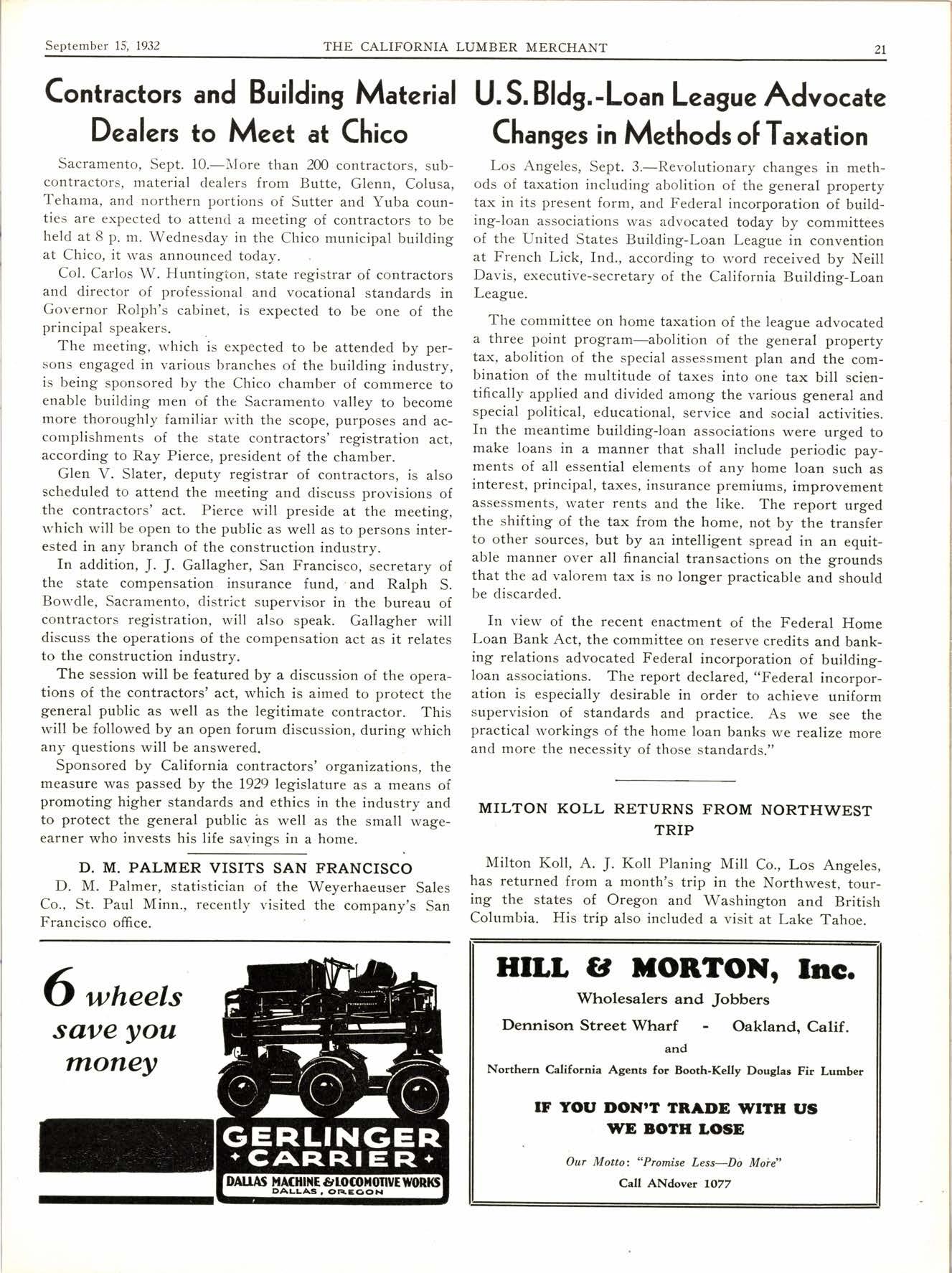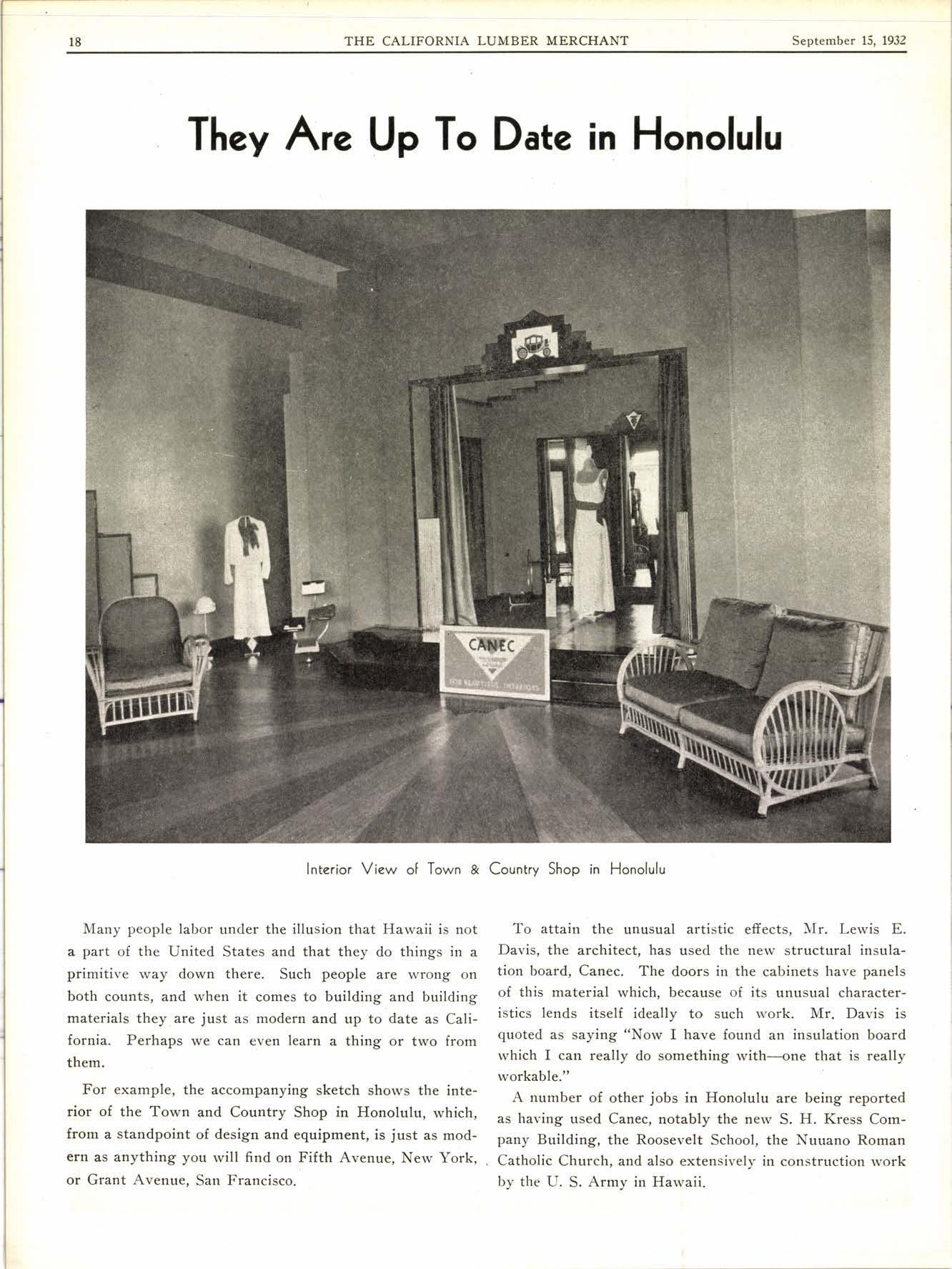
3 minute read
National Leaders Discuss Problems of Lumber Industry
Concert of Action Ursed for Timber Tax Adjustment
Eugene, Oregon, August 26.-l\Ieeting in the most heavily timbered county of the United States, Lane County, C)regon, lumbermen of Western Oregon rvere provided rvith the proper setting for a discussion of national lumber industry affairs. Dr. Wilson Compton, SecretaryManager of the National Lumber Manufacturers Association, introduced by A. C. Dixon, immediate past president of the National, explained the rvork of the U. S. Timber' Conservation Board appointed by President Hoover.
"The Timber Conservation Board, formed to lead the solution of lumber industry problems by civic and public lneans, has placed the equitable rvorking out of the timber tax problern at the head of its program," said Dr. Compton, "and is nolv endeavor ing to clevelop a concert of action by the principal timber states to relieve the inclustry of this impossible burden." IJased on business of the first six months of this year, it appears that the gross income of the lumber industry of the United States for 1932 rvould be about $165,000,000, with no net income, but rvith a tax bill of about $60,000,000 which must be paicl by reserve or by other means, he said. Dr. Compton rrrgecl that each state by cooperative national action develop an acljusted tax plan that u'ould not continue to force unnrarrantecl and trneconomical liqrridation of assets by forcecl timbcr cutting.
hl referring to the tariff cluestion, I)r. Cotnpton callecl attention to tl-re present tariff expiring bv limitation in less than trvo years and explained that the industry shoulcl begin norv the planning of a permanent tariff proglanr rvhich shotrlcl balance barriers set by other countries ancl provide permanent depenclable tnarkets. "Jiffective tracle promotion and research shoulcl be a clefinite part of an1, lnmber industry progranl if the inclustry is to compete efficiently today," stated Dr. Compton. In closing he praised the highly productive effort of Oregon's junior U. S. Senator, Fred W. Steirver, in behalf of the lumber industry.
Announcing the inclusion of 75/o of the Douglas Fir manufacturers as members of the West Coast Lumbermen's Association, Colonel \,\r. B. Greeley, Secretary-Mauager, stated that he believ<'d the economic tide had turned. He referrecl to the rvork of the Reconstmction Finance Corporation making funcls for railroacl rnaintenance available as a good sign for r-nore lumber 'l>usiness. Since the Home Loan Bank bill rvould directly add impetus to home construction which chiefly involved use of wood, Colonel Greeley believed the lumber industry rvoulcl soon benefit by further increased sales in the near future.
Senator Fred W. Steiwer, introduced by Dr. Compton as the most diligent and courageous man sent to Congress from states west of the Mississippi in the last decade, stated he considerecl it a real privilege to rvork with such leadels as Dr. Compton and Colonel Greeley. He praised Dr. Compton as the outstanding national leader of the Iumber industry and Colonel Greeley as the outstanding practical conservationist.
"The public must be taken into confidence by the luml>er industry," said Senator Steiwer, "for an intelligent cooperative rvorking out of tax, tariff and trade promotion problems." He emphasized the necessity also of assisting efforts of Congless to provide a modification of the Sherman Anti-Trust Lar.v to rnake possible true conservation of our country's national resources. "Tax law adjustment is a state matter," he said, "but federal government cooperation can be obtained to provide the concert of action by principal timber states pointed out by Dr. Compton." Lumber manufacturers were doing a real public service in continuing employment rvherever possible in present times because in so doing they reduce the class of idle men which always follow a period o{ slack employment and are never again absorbed by industry.
President Jack Magladry, of the Willamette Valley Lumbermen's Association, presided at the meeting attended by 170 lumbermen and introduced others of prominence in lumber industry affairs who spoke briefly. These were 'l'cmnrv Rrrssell. Chairman of tl-re E,ugene Chamber of Commerce ; C. C. Crorv, ltrrlllisher of Crow's Digest; F. P. Gram, F. P. Gram Compar.ry, Inc., Portland, Oregon, H. E. Veness representing W. C. Reugnitz, President of the 4-L, and Charles Early, Chairman of the Oregon Industrial Accident Commission.
During the rneeting President I\Iagladry announced the union of the Williamette Valley Lumbermen's Association as a unit of the West Coast l-umbermen's Association, stating the action had been taken that afternoon at a meeting of their directors witn Colonel Greeley. This action becomes effective October first with the office at Eugene continued in charge of Herbert Cox, now Secretary of the Williamette Valley Lumbermen's Association.
The Pacilic Lumber Co. Exhibit at state Fair
The Pacific Lumber Company, San Francisco, had an exhibit of insulating material at the California State Fair, Sacramento. Edric Brotvn, rvho has charge of the company's by-products division, was in charge of the exhibit, and reports increasing interest by dealers and the public in Palco Reclrvood Bark Fibre.
%ere6athreeM room home yr'th asmaller arnount of.Yuate foobre tlzan ls rcia,/lv taheizap ln a ftre rodm house- 'Jlze more you studv the e/eastfrq exteridr and compdct frorT?*arranqement tlte ar@,ter will be your desire tobut/d dhome fYom tltis ideal plan. - -b
Plans fot this attractive home can be furnirhod by thc










